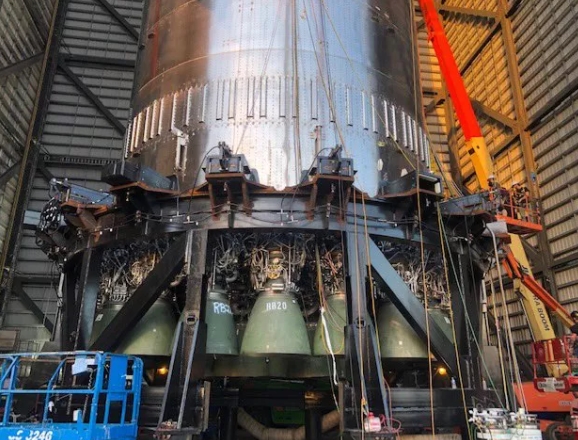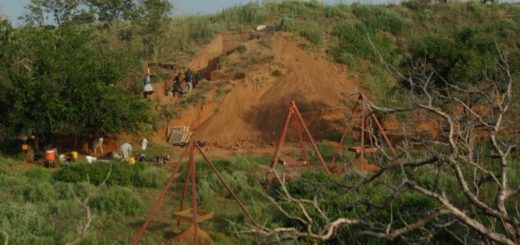SpaceX installs 29 engines on giant Super Heavy Mars rocket

SpaceX plans to launch the first orbital test flight of Starship, its reusable deep-space transportation system, in the next few months from the company’s South Texas site, near the Gulf Coast village of Boca Chica.
The company has made significant strides toward that milestone in the past few days, getting Starship’s giant first-stage booster, known as Super Heavy, ready to fly.
“Installing Starship booster engines for first orbital flight,” SpaceX founder and CEO Elon Musk said via Twitter yesterday (Aug. 1) in a post that included a photo of the rocket, with himself holding his young son nearby. And today (Aug. 2), Musk tweeted a close-up photo of Super Heavy’s base, which is now bristling with Raptor engines.
Related: SpaceX’s Starship and Super Heavy rocket in pictures
“Installing Starship booster engines for first orbital flight,” SpaceX founder and CEO Elon Musk wrote about this photo, which he posted on Twitter on Aug. 1, 2021.
“Installing Starship booster engines for first orbital flight,” SpaceX founder and CEO Elon Musk wrote about this photo, which he posted on Twitter on Aug. 1, 2021. (Image credit: Elon Musk via Twitter)
Super Heavy will initially sport 29 Raptors, and future versions will have 32 of the engines, Musk has said. Starship’s upper stage, a 165-foot-tall (50 meters) spacecraft called Starship, will be powered by six additional Raptors.
Three-engine Starship prototypes have flown multiple times, on test flights that reached a maximum altitude of 6.2 miles (10 kilometers). In May, a vehicle known as SN15 (“Serial No. 15”) became the first to ace this high-altitude hop, surviving its touchdown intact. (Several of SN15’s predecessors did well until the very end, failing to stick the landing.)
SN15’s success cleared the way for the coming orbital flight, which will be the first liftoff of a Super Heavy vehicle. A fully stacked Starship, consisting of a Super Heavy known as Booster 4 and the SN20 upper-stage prototype, will launch from South Texas.
Click here for more Space.com videos…
Shortly after liftoff, Booster 4 will splash down in the Gulf of Mexico. Meanwhile, SN20 will power itself to orbit, making a splashdown of its own in the Pacific Ocean near the Hawaiian island of Kauai, about 90 minutes after launch.
SpaceX hopes to launch this uncrewed test flight before the end of the year. However, the company will have to overcome logistical as well as technical hurdles to make that happen. For example, the U.S. Federal Aviation Administration is conducting an environmental review of Starship’s launch operations, and it’s unclear when that will conclude.



 Creators of mankind
Creators of mankind Description of “Tall white aliens”
Description of “Tall white aliens” Where they came from?
Where they came from? About hostile civilizations
About hostile civilizations The war for the Earth
The war for the Earth “Tall white aliens” about eternal life
“Tall white aliens” about eternal life Video: “Nordic aliens”
Video: “Nordic aliens” Aliens
Aliens Alien encounters
Alien encounters The aliens base
The aliens base UFO
UFO Technology UFO
Technology UFO Underground civilization
Underground civilization Ancient alien artifacts
Ancient alien artifacts Military and UFO
Military and UFO Mysteries and hypotheses
Mysteries and hypotheses Scientific facts
Scientific facts


















